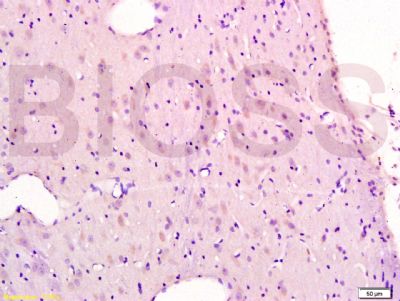5HT1B Receptor Polyclonal Antibody
Purified Rabbit Polyclonal Antibody (Pab)
- SPECIFICATION
- CITATIONS
- PROTOCOLS
- BACKGROUND

Application
| WB, IHC-P, IHC-F, IF |
|---|---|
| Primary Accession | P28222 |
| Reactivity | Rat, Pig, Dog, Bovine |
| Host | Rabbit |
| Clonality | Polyclonal |
| Calculated MW | 44 KDa |
| Physical State | Liquid |
| Immunogen | KLH conjugated synthetic peptide derived from human 5-HTR1B |
| Epitope Specificity | 121-220/390 |
| Isotype | IgG |
| Purity | affinity purified by Protein A |
| Buffer | 0.01M TBS (pH7.4) with 1% BSA, 0.02% Proclin300 and 50% Glycerol. |
| SUBCELLULAR LOCATION | Cell membrane; Multi-pass membrane protein. |
| SIMILARITY | Belongs to the G-protein coupled receptor 1 family. |
| Post-translational modifications | Phosphorylated. Desensitization of the receptor may be mediated by its phosphorylation. Palmitoylated. |
| Important Note | This product as supplied is intended for research use only, not for use in human, therapeutic or diagnostic applications. |
| Background Descriptions | The neurotransmitter serotonin (5-hydroxytryptamine; 5-HT) exerts a wide variety of physiologic functions through a multiplicity of receptors and may be involved in human neuropsychiatric disorders such as anxiety, depression, or migraine. These receptors consist of several main groups subdivided into several distinct subtypes on the basis of their pharmacologic characteristics, coupling to intracellular second messengers, and distribution within the nervous system (Zifa and Fillion, 1992 [PubMed 1359584]). The serotonergic receptors belong to the multigene family of receptors coupled to guanine nucleotide-binding proteins.[supplied by OMIM, Oct 2009]. |
| Gene ID | 3351 |
|---|---|
| Other Names | 5-hydroxytryptamine receptor 1B, 5-HT-1B, 5-HT1B, S12, Serotonin 1D beta receptor, 5-HT-1D-beta, Serotonin receptor 1B, HTR1B, HTR1DB |
| Dilution | WB=1:500-2000,IHC-P=1:100-500,IHC-F=1:100-500,IF=1:100-500 |
| Storage | Store at -20 ℃ for one year. Avoid repeated freeze/thaw cycles. When reconstituted in sterile pH 7.4 0.01M PBS or diluent of antibody the antibody is stable for at least two weeks at 2-4 ℃. |
| Name | HTR1B (HGNC:5287) |
|---|---|
| Synonyms | HTR1DB |
| Function | G-protein coupled receptor for 5-hydroxytryptamine (serotonin) (PubMed:10452531, PubMed:1315531, PubMed:1328844, PubMed:1348246, PubMed:1351684, PubMed:1559993, PubMed:1565658, PubMed:1610347, PubMed:23519210, PubMed:23519215, PubMed:29925951, PubMed:8218242). Also functions as a receptor for ergot alkaloid derivatives, various anxiolytic and antidepressant drugs and other psychoactive substances, such as lysergic acid diethylamide (LSD) (PubMed:23519210, PubMed:23519215, PubMed:29925951). Ligand binding causes a conformation change that triggers signaling via guanine nucleotide-binding proteins (G proteins) and modulates the activity of downstream effectors, such as adenylate cyclase (PubMed:10452531, PubMed:1315531, PubMed:1328844, PubMed:1348246, PubMed:1351684, PubMed:1559993, PubMed:1565658, PubMed:1610347, PubMed:23519210, PubMed:23519215, PubMed:29925951, PubMed:8218242). HTR1B is coupled to G(i)/G(o) G alpha proteins and mediates inhibitory neurotransmission by inhibiting adenylate cyclase activity (PubMed:29925951, PubMed:35610220). Arrestin family members inhibit signaling via G proteins and mediate activation of alternative signaling pathways (PubMed:29925951). Regulates the release of 5-hydroxytryptamine, dopamine and acetylcholine in the brain, and thereby affects neural activity, nociceptive processing, pain perception, mood and behavior (PubMed:18476671, PubMed:20945968). Besides, plays a role in vasoconstriction of cerebral arteries (PubMed:15853772). |
| Cellular Location | Cell membrane; Multi-pass membrane protein |
| Tissue Location | Detected in cerebral artery smooth muscle cells (at protein level). Detected in brain cortex, striatum, amygdala, medulla, hippocampus, caudate nucleus and putamen. |

Thousands of laboratories across the world have published research that depended on the performance of antibodies from Abcepta to advance their research. Check out links to articles that cite our products in major peer-reviewed journals, organized by research category.
info@abcepta.com, and receive a free "I Love Antibodies" mug.
Provided below are standard protocols that you may find useful for product applications.
If you have used an Abcepta product and would like to share how it has performed, please click on the "Submit Review" button and provide the requested information. Our staff will examine and post your review and contact you if needed.
If you have any additional inquiries please email technical services at tech@abcepta.com.













 Foundational characteristics of cancer include proliferation, angiogenesis, migration, evasion of apoptosis, and cellular immortality. Find key markers for these cellular processes and antibodies to detect them.
Foundational characteristics of cancer include proliferation, angiogenesis, migration, evasion of apoptosis, and cellular immortality. Find key markers for these cellular processes and antibodies to detect them. The SUMOplot™ Analysis Program predicts and scores sumoylation sites in your protein. SUMOylation is a post-translational modification involved in various cellular processes, such as nuclear-cytosolic transport, transcriptional regulation, apoptosis, protein stability, response to stress, and progression through the cell cycle.
The SUMOplot™ Analysis Program predicts and scores sumoylation sites in your protein. SUMOylation is a post-translational modification involved in various cellular processes, such as nuclear-cytosolic transport, transcriptional regulation, apoptosis, protein stability, response to stress, and progression through the cell cycle. The Autophagy Receptor Motif Plotter predicts and scores autophagy receptor binding sites in your protein. Identifying proteins connected to this pathway is critical to understanding the role of autophagy in physiological as well as pathological processes such as development, differentiation, neurodegenerative diseases, stress, infection, and cancer.
The Autophagy Receptor Motif Plotter predicts and scores autophagy receptor binding sites in your protein. Identifying proteins connected to this pathway is critical to understanding the role of autophagy in physiological as well as pathological processes such as development, differentiation, neurodegenerative diseases, stress, infection, and cancer.


